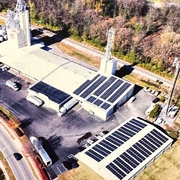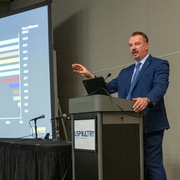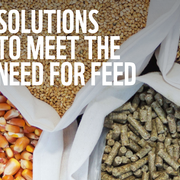IFEEDER Fodder
-

- October 25, 2024
- Ration Innovation: A Path to Reducing the Environmental Footprint of Animal Production and Pets
-
The animal food industry has an opportunity to support our customers with their environmental goals. Input from 11 U.S. and Canadian organizations representing those customers helped the Institute for Feed Education and Research (IFEEDER) identify metrics of interest relative to greenhouse gas emissions, water quality, water quantity and land and marine resource use. Collectively, those metrics provide insights into an aim to reduce their environmental footprint (learn more about those metrics in my previous blog).
- By Lara Moody
-

- September 26, 2024
- Powering Profitability: How Feed Industry Companies are Addressing Energy Use for Long-Term Sustainability
-
Energy, including fuel, electricity, heating, cooling and steam generation, is a significant cost for the feed industry. Several members of the American Feed Industry Association (AFIA) have been working to reduce energy costs by switching to more efficient equipment, developing more efficient processes and investing in renewable energy generation.
- By Erica Burson
-

- September 9, 2024
- Where Are Our Customers Focusing Their Sustainability Efforts?
-
It is one thing to consider our own animal food industry’s sustainability efforts, but it is equally important to consider the needs of our customers. We, being members of the feed and pet food industry, are an upstream source within their supply chain, but we may be well positioned to help them meet their identified goals and targets.
- By Lara Moody
-

- August 14, 2024
- Worker Safety is a Fundamental Aspect of Corporate Sustainability
-
Earlier in my career, as a contractor, I attended a transportation company meeting. Agenda item one was to participate in a safety briefing, where we learned where the exits were, any hazards we could encounter and what to do in an emergency. This impressed upon me that this company’s culture prioritized safety for its customers and workers.
- By Erica Burson
-

- July 16, 2024
- New IFEEDER Resource Showcases Industry Sustainability Stories
-
Sure, greenhouse gas emission reductions often get the limelight when it comes to corporate sustainability programs, but sustainability goes much broader than climate change. Consider the issues that matter most to them, i.e., conducting a “materiality assessment,” as a key step in deciding where the company should focus its sustainability efforts to make an impact. This concept can be confusing, so I break it down here and explain a new resource that the Institute for Feed Education and Research is launching to help companies understand it even better.
- By Lara Moody
-

- May 6, 2024
- Navigating ESG: A Corporate Journey
-
At the recent International Production & Processing Expo (IPPE), the American Feed Industry Association hosted an educational session called, “Feed Your ESG: How Feed Will Help Hit Sustainability Targets.” While I spoke about Institute for Feed Education and Research’s sustainability efforts underway to support the feed industry and our customers, I took away much more from the panel discussion with Mike Gauss, president of KENT Nutrition Group, who shared insights into his company’s efforts to advance ESG in practice.
- By Lara Moody
-

- March 11, 2024
- Why Dietary Change Is Not the Path to Reducing Animal Agriculture's Environmental Footprint
-
The International Production and Processing Expo (IPPE) is an important opportunity for meetings and networking and also where great opportunities for learning occur. I had the opportunity to participate in the Animal Agriculture Sustainability Summit, hosted by the American Feed Industry Association, Meat Institute, and U.S. Poultry and Egg Association.
- By Lara Moody
-

- July 6, 2023
- Innovation and Feed: How Animal Ag Can Reduct Its Environmental Footprint
-
As the agrifood sector seeks opportunities to use feed to reduce the environmental footprint of animal production, the discussion focused on the importance of innovation in its many forms — linking solutions from feedstuff production to the rations consumed by the animals.
- By AFIA Editor
-

- June 28, 2023
- Feed Innovation Can Lower Environmental Footprints
-
Feedstuff production on the farm may be a leading source of the environmental footprint for livestock, poultry, horses and pets, but it doesn’t mean it will be the best solution for reducing it. Regenerative agriculture, climate-smart practices and efforts to improve soil health are agricultural practices that receive a lot of attention by stakeholders for reducing t animal feed’s footprint, but I would argue that we must give equal attention to some of the animal food industry innovations in the pipeline that will offer solutions as well.
- By Lara Moody
-

- April 27, 2023
- Collaboration is Key to Meeting the Need for Feed
-
Over the past year, I’ve been lucky to collaborate with many American Feed Industry Association and Institute for Feed Education and Research staff and members, forging the first-ever partnership between our organizations. The goal was to elevate a vision that feed and animal nutrition can be a critical lever in providing sustainable solutions to food systems.
- By Guest